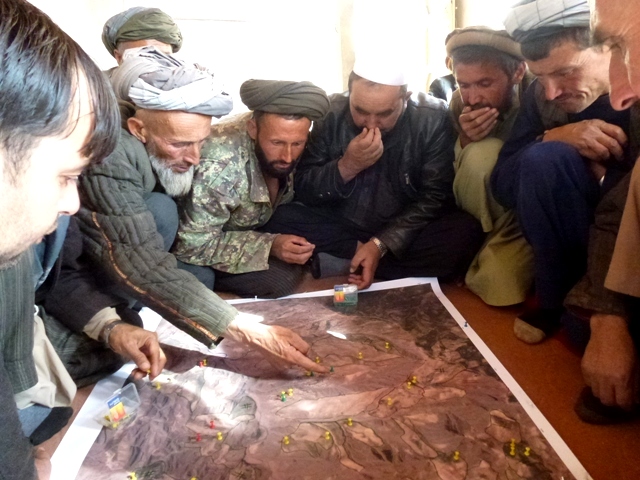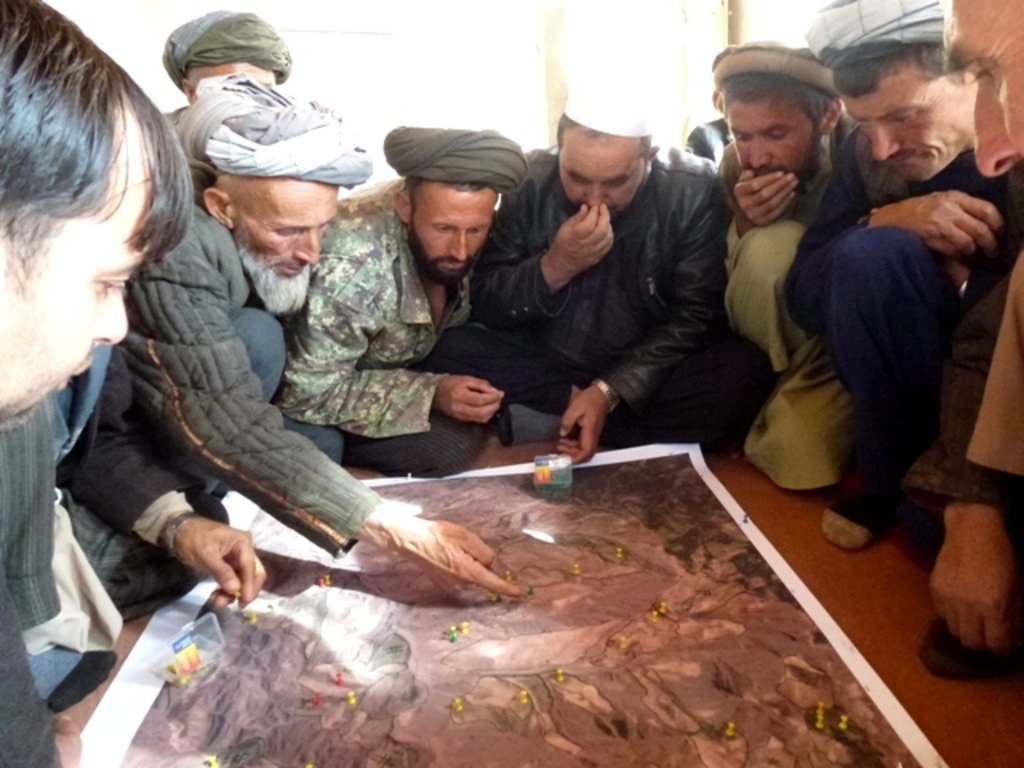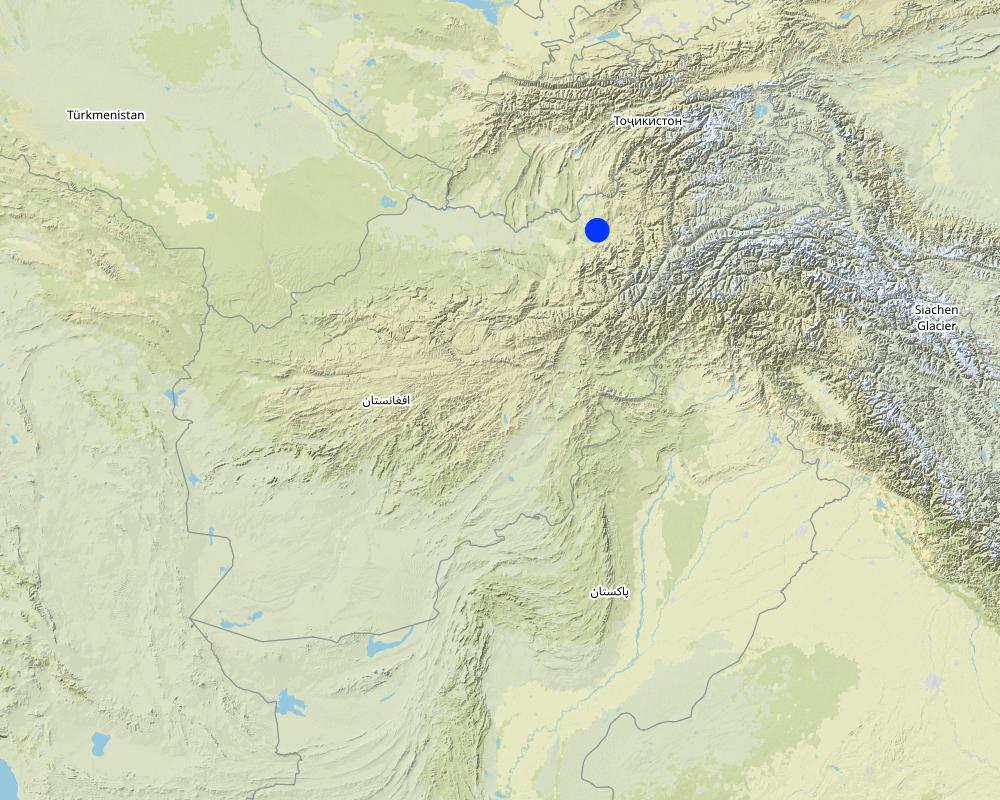Watershed Associations (WSA) and Natural Resource Management Committees (NRMC) [Afeganistão]
- Criação:
- Atualização:
- Compilador/a: Bettina Wolfgramm
- Editores: Roziya Kirgizbekova, Aqila Haidery
- Revisor: William Critchley
approaches_545 - Afeganistão
Veja as seções
Expandir tudo Recolher tudo1. Informação geral
1.2 Detalhes do contato das pessoas capacitadas e instituições envolvidas na avaliação e documentação da abordagem
Nome do projeto que facilitou a documentação/avaliação da Abordagem (se relevante)
Potential and limitations for improved natural resource management (NRM) in mountain communities in the Rustaq district, Afghanistan (Rustaq NRM Study)Nome da(s) instituição(ões) que facilitou(ram) a documentação/avaliação da Abordagem (se relevante)
Terre des Hommes (Terre des Hommes) - SuíçaNome da(s) instituição(ões) que facilitou(ram) a documentação/avaliação da Abordagem (se relevante)
CDE Centre for Development and Environment (CDE Centre for Development and Environment) - Suíça1.3 Condições em relação ao uso da informação documentada através de WOCAT
Quando os dados foram compilados (no campo)?
17/10/2016
O/a compilador/a e a(s) pessoa(s) capacitada(s) aceitam as condições relativas ao uso de dados documentados através da WOCAT:
Sim
1.4 Referência ao(s) questionário(s) sobre tecnologias da GST
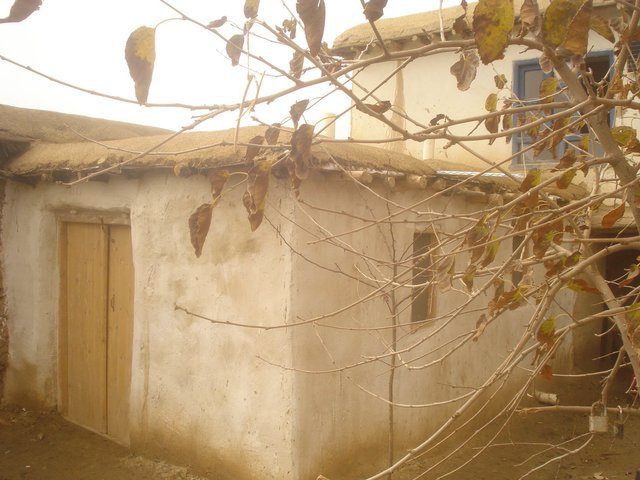
Improved livestock shed for better health and productivity [Afeganistão]
Existing livestock sheds can be improved through interior and exterior refurbishing, and door and window installation. More favourable indoor conditions benefit animal health and the quality of animal products.
- Compilador/a: Bettina Wolfgramm
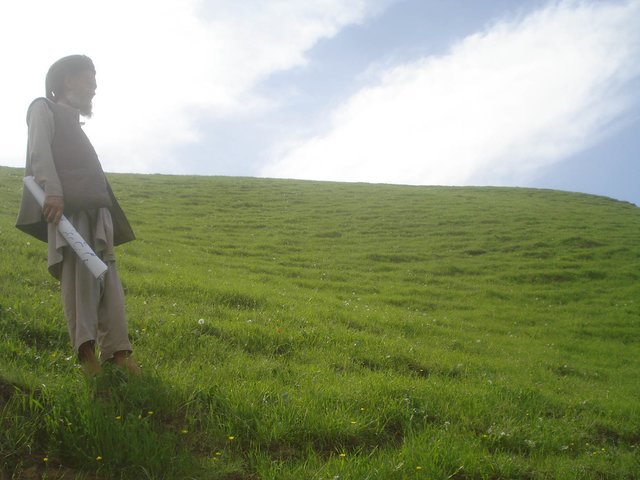
Rotational grazing to restore degraded pastures [Afeganistão]
A plan for rotational grazing has been developed to control pasture use and prevent overgrazing of rehabilitated pastures.
- Compilador/a: Bettina Wolfgramm
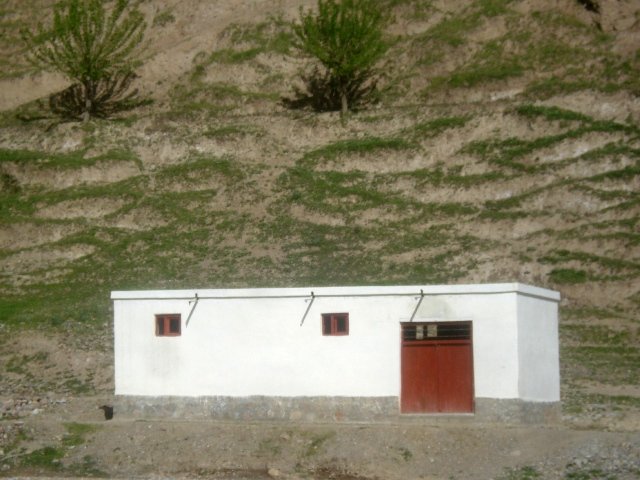
Community fodder bank for sustaining supplies [Afeganistão]
Community fodder banks have been established in villages for the purpose of ensuring supplies of livestock fodder during winter, to prevent loss of livestock and to prevent over-grazing early in spring.
- Compilador/a: Bettina Wolfgramm
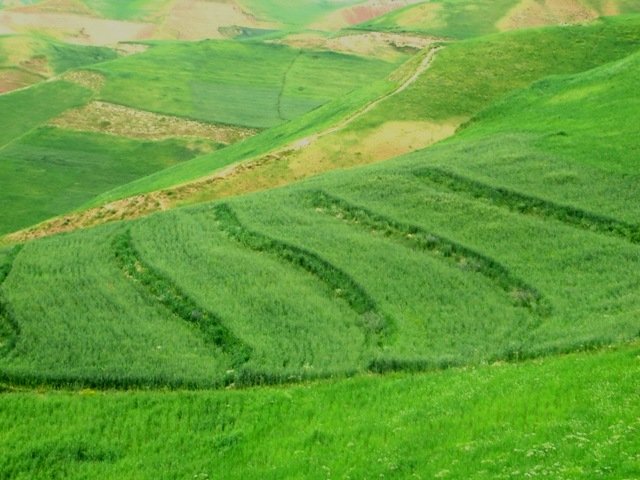
Terraces with improved seed and fertilizer application [Afeganistão]
Terraces are established on mountain slopes used mainly for cropping wheat, with the purpose of soil protection from erosion, preserving runoff, sediments and nutrients on-site. Improved seeds and fertilizer are applied on the terraces for increasing crop yield, but also vegetation cover and biomass production, and thus prevent further land …
- Compilador/a: Roziya Kirgizbekova
2. Descrição da abordagem de GST
2.1 Descrição curta da abordagem
Two Watershed Associations (WSA), in Chaker and Nahristan watershed areas respectively, are registered at the national level with the Ministry of Agriculture Irrigation and Livestock (MAIL) and at the regional level with the Department of Agriculture. Both associations are strong, active, dynamic, and have the capacity to coordinate and support the Natural Resource Management Committees (NRMC) at village level.
2.2 Descrição detalhada da abordagem
Descrição detalhada da abordagem:
Terre des Hommes (Tdh) has been implementing the Livelihood project (LIPT) in Rustaq district in northern Afghanistan since 2007. The overall aim of the project is to offer the rural population new and improved livelihood options, with capacity building of the rural population, to design and implement their own sustainable development options, and to enhance their resilience to cope with natural and conflict-related stress. For this purpose, capacity of supporting stakeholder institutions is strengthened (LIPT’s boundary partners) to ensure that good development is on-going. Boundary partners are trained and equipped in relevant techniques regarding sustainable natural resource management.
Two Watershed Associations (WSA) and 20 Natural Resources Management Committees (NRMC) were founded through LIPT. Two WSAs, in Chaker and Nahristan watershed areas, are registered at national level within the Ministry of Agriculture Irrigation and Livestock (MAIL), and at the regional level with the Department of Agriculture. Both associations are strong, active, dynamic, and have the capacity to coordinate and support the NRMCs at village level. Out of their newly established and registered regional offices, the WSAs coordinate the NRMCs, take over responsibilities from Tdh (e.g. the 2014 reforestation campaign) and are getting more involved in planning and monitoring of LIPT’s activities. The 20 NRMCs have "hands and eyes" on all LIPT activities implemented in their communities, and their trained extension workers render valuable services to the farmers in their villages.
Methods: Today, all NRMCs have a strong institutional set-up. Their extension workers have been trained and equipped. Members of NRMCs and WSAs have been trained on group management, planning, documentations, record keeping, IPM, reforestation management, soil protection, mulching, hedgerows and terracing, making fermenters, pruning and budding. WSAs and NRMCs gained further organizational, technical and management capacity building in both watershed areas. As one of biggest challenge at watershed level is soil erosion within hillside agriculture, LIPT III trained the NRMCs and WSAs on terracing and hedgerows to protect the soil from erosion. Furthermore, NRMCs were trained in sustainable irrigation water management, gully treatment, and surface water harvesting. There were also training courses conducted on leadership, finance, proposal writing, documentation, procurement and operations management.
Both WSAs and NRMCs started to get a real understanding of environmental issues and were then able to motivate their communities. WSAs coordinated the NRM intervention with NRMCs including reforestation, soil protection hedgerows, contour lines, terracing, establishment of public nurseries (to produce trees and be an income source for WSAs), establishment of centralized community bakeries (to reduce the demand for firewood and decrease the women’s workload in the watershed areas), irrigation infrastructure, bio-engineering and gully control (to reduce the progression of gullies on both ploughed lands and pastures), livestock value chains at regional (watershed) level, etc., while NRMCs are looking after these interventions and the mobilization of the community at the village level. Farmers and communities have adopted natural resource management practices to maintain/increase soil fertility, rangeland, water resources and forest coverage.
2.3 Fotos da abordagem
2.5 País/região/locais onde a abordagem foi aplicada
País:
Afeganistão
Região/Estado/Província:
Tahor Province, Rustaq districts
Especificação adicional de localização:
Dashti Mirzai, Javaz Khana and Sari Joy villages
Map
×2.6 Datas de início e término da abordagem
Indique o ano de início:
2007
Caso o ano exato seja desconhecido, indique a data aproximada de início da abordagem:
menos de 10 anos atrás (recentemente)
2.7 Tipo de abordagem
- Baseado em projeto/programa
2.8 Principais metas/objetivos da abordagem
The main aim of the project is to offer the rural population new and improved livelihood options and to deliver capacity building for the rural population to design and implement their own sustainable development options and enhance their resilience to cope with natural and conflict related stress.
2.9 Condição que propiciam ou inibem a implementação de tecnologia/tecnologias aplicada(s) segundo a abordagem
Normas e valores sociais/culturais/religiosos
- Propício
The functions of men and women are clearly distinguished within Afghan society, while at the same time within the family this division of work and functions also results in men and women working hand-in-hand. An improvement of the family’s livelihood situation is expected to positively affect all family members. However. it is recognized that the involvement of women is key in order to secure basic human rights for everyone, to achieve good governance, sustainable development, and to efficiently contribute to poverty reduction (SDC 2004), it is also clear that a context sensitive approach is of high importance.
- Inibitivo
Lack of capacity of the rural population to design and implement sustainable development options; vulnerability to natural and conflict related stress
Quadro institucional
- Propício
Establishment of Watershed Associations (WSA) and Natural Resources Management Committees (NRMC)
- Inibitivo
Lack of institutions at the community level to introduce natural resource management options
Conhecimento sobre GST, acesso a suporte técnico
- Propício
Training has improved technical knowledge
- Inibitivo
Lack of technical knowledge
3. Participação e papel das partes interessadas envolvidas
3.1 Partes interessadas envolvidas na abordagem e seus papéis
- Usuários de terra/comunidades locais
The overall aim of the project is to offer the rural population new and improved livelihood options and give capacity building to the rural population to design and implement their own sustainable development options, and enhance their resilience to cope with natural and conflict related stress.
- Organizações comunitárias
Watershed Associations (WSA) and Natural Resources Management Committees (NRMC)
- Organização internacional
Terre des Hommes , SDC
3.2 Envolvimento do usuários de terra/comunidades locais nas diferentes fases da abordagem
| Envolvimento do usuários de terra/comunidades locais | Especifique quem estava envolvido e descreva as atividades | |
|---|---|---|
| Iniciação/motivação | Nenhum | |
| Planejamento | Participativo | |
| Implementação | Participativo | |
| Monitoramento/avaliação | Participativo |
3.4 Decisão sobre a seleção de tecnologia/tecnologias de GST
Especifique quem decidiu sobre a seleção de tecnologia/tecnologias a serem implementadas:
- todos os atores relevantes, como parte de uma abordagem participativa
4. Suporte técnico, reforço das capacidades e gestão do conhecimento
4.1 Reforço das capacidades/ formação
Foi oferecida formação aos usuários da terra/outras partes interessadas?
Sim
Especifique quem foi capacitado:
- Usuários de terra
- Equipe de campo/consultores
4.2 Serviço de consultoria
Os usuários de terra têm acesso a um serviço de consultoria?
Sim
Especifique se foi oferecido serviço de consultoria:
- nas áreas dos usuários da terra
4.3 Fortalecimento da instituição (desenvolvimento organizacional)
As instituições foram fortalecidas ou estabelecidas através da abordagem?
- Sim, moderadamente
Especifique a que nível (níveis) as instituições foram fortalecidas ou estabelecidas:
- Local
- Regional
- Nacional
Descreva instituição, papéis e responsabilidades, membros, etc.
LIPT III will leave behind successful and strong boundary partners in place to carry out the development options, as main boundary partners (WSAs, NRMCs, as the major boundary partners) will have a source of income for their operation and management.
Especifique o tipo de apoio:
- Financeiro
- Reforço das capacidades/ formação
- Equipamento
4.4 Monitoramento e avaliação
Monitoramento e avaliação são partes da abordagem?
Sim
4.5 Pesquisa
A pesquisa foi parte da abordagem?
Sim
Especifique os tópicos:
- Economia/Marketing
- Tecnologia
Dê mais detalhes e indique quem realizou a pesquisa:
On-going research, as well as multiple trials by LIPT to find the best-adapted technical solutions, to communicate and discuss them with local communities and farmers, were the key elements of this success.
5. Financiamento e apoio material externo
5.1 Orçamento anual para o componente de GST da abordagem
Caso o orçamento exato seja desconhecido, indique a faixa:
- 10.000-100.000
5.2 Apoio financeiro/material concedido aos usuários da terra
Os usuários da terra receberam apoio financeiro/material para a implementação de tecnologia/tecnologias?
Sim
Caso afirmativo, especifique tipo(s) de apoio, condições e fornecedor(es):
Fully supported under project
5.4 Crédito
Foi concedido crédito segundo a abordagem para atividades de GST?
Não
5.5 Outros incentivos ou instrumentos
Foram utilizados outros incentivos ou instrumentos para promover a implementação das tecnologias de GST?
Sim
Caso afirmativo, especifique:
local institution were support with equipment
6. Análise de impactos e declarações finais
6.1 Impactos da abordagem
A abordagem auxiliou os usuários da terra a implementar e manter as tecnologias de GST?
- Não
- Sim, pouco
- Sim, moderadamente
- Sim, significativamente
NRM is the area where LIPT III made the most remarkable progress despite the fact that NRM was a completely new approach, and its implementation is highly demanding in terms of manpower, community awareness and mobilization. Profound changes in behaviour, motivation and mobilization both at individual and community levels made this possible. On-going research, as well as multiple trials by LIPT to find the best-adapted technical solutions, and to communicate and discuss them with local communities and farmers, were the key elements of this success. The NRMCs, WSAs as well as individual farmers in both watershed areas increased their knowledge and gained a better understanding of the importance of sustainable management, rehabilitation of farm land, pastures and their main natural resources. Farmers adapt and replicate the innovations once they see the results, farmers interest became high and they are ready to replicate it to protect their land form degradation.
A abordagem aprimorou o conhecimento e as capacidades dos usuários da terra para implementar a GST?
- Não
- Sim, pouco
- Sim, moderadamente
- Sim, significativamente
Farmers adapt and replicate the innovations. Once they see the results, farmers' interest became high and they are ready to replicate it to protect their land from degradation.
A abordagem resultou em emprego, oportunidades de renda?
- Não
- Sim, pouco
- Sim, moderadamente
- Sim, significativamente
One Example: Under irrigation water improvement interventions, LIPT in coordination with NRMCs brought more 110 ha land under irrigation and the yield is expected to be doubled in this agricultural land, and NRMCs are trained on sustainable irrigation water management, gully treatment, and surface water harvesting
6.2 Principal motivação dos usuários da terra para implementar a GST
- Produção aumentada
- Degradação do solo reduzida
- Riscos de desastre reduzido
6.3 Atividades de sustentabilidade de abordagem
Os usuários da terra podem manter o que foi implementado através da abordagem (sem apoio externo)?
- Sim
Caso afirmativo, descreva como:
To look to the capacity and institutional strengthening of the project boundary partners, LIPT III will leave behind a successful and strong boundary partner in place to carry out the development options, as main boundary partners will have source of income (nurseries, cooperative shop, etc.) for their operation and management.
6.4 Pontos fortes/vantagens da abordagem
| Pontos fortes/vantagens/oportunidades na visão do usuário da terra |
|---|
| The traditional social structures and customary institutions play an important role in problem solving in everyday community life, but traditional problem solving structures may also limit the taking up of new approaches. More effective approaches are needed, for example in the field of the management of common pool resources (water, pastures, trees and shrubs). The newly established Watershed Associations demonstrate how groups addressing specific urgent tasks may be successfully established and functioning within a very short period of time. |
|
NRM is the area where LIPT III made the most remarkable progress despite the fact that NRM was a completely new approach, and its implementation is highly demanding in terms of manpower, community awareness and mobilization. Profound changes in behaviour, motivation and mobilization both at individual and community levels made this possible. The permanent research, as well as multiple trials by LIPT to find the best-adapted technical solutions, to communicate and discuss them with local communities and farmers were the key elements of this success. WSAs and NRMCs are playing an active role in implementation of NRM intervention, even they have become more interested and active when they registered in Department of Agriculture Irrigation and Livestock at national and regional level. |
| Farmers adapt and replicate the innovations once they see the results, as soil erosion is the main concern in Rustaq - but nobody in watershed area was ready to protect their agriculture land by implementing barrier hedgerows. After demonstrating of hedgerow by LIPT III, farmers saw its impact on controlling of soil erosion, farmers' interest became high and they are ready to replicate it to protect their land from degradation. |
|
All community extension workers are trained and in place, playing an essential role in supporting the boundary partners in implementing NRM activities that include community mobilization, technical design of orchards and nurseries, reforestation sites, terracing and hedgerow designs. The NRMCs, WSAs as well as individual farmers in both watershed areas increased their knowledge and gained better understanding of the importance of sustainable management, rehabilitation of farmland, pastures and their main natural resources. A high degree of motivation and mobilization of farmers, and adequate technical capacity of CEWs regarding NRM is certainly one of the main outcomes of the LIPT, and an essential step towards the fulfilment of LIPT’s mission. |
| Pontos fortes/vantagens/oportunidades na visão do/a compilador/a ou de outra pessoa capacitada |
|---|
| A rewarding sign of the development of NRM awareness is how farmers took up the problem of soil erosion.100 ha of cultivable land on hillsides have been terraced since the terracing activity had been initiated in November 2013. And 155 ha of additional land are in the process of being terraced. The biggest success with terracing is that a number of farmers started replication themselves what they had seen. |
7. Referências e links
7.1 Métodos/fontes de informação
- visitas de campo, pesquisas de campo
- compilação de relatórios e outra documentação existente
Links e módulos
Expandir tudo Recolher tudoLinks

Improved livestock shed for better health and productivity [Afeganistão]
Existing livestock sheds can be improved through interior and exterior refurbishing, and door and window installation. More favourable indoor conditions benefit animal health and the quality of animal products.
- Compilador/a: Bettina Wolfgramm

Rotational grazing to restore degraded pastures [Afeganistão]
A plan for rotational grazing has been developed to control pasture use and prevent overgrazing of rehabilitated pastures.
- Compilador/a: Bettina Wolfgramm

Community fodder bank for sustaining supplies [Afeganistão]
Community fodder banks have been established in villages for the purpose of ensuring supplies of livestock fodder during winter, to prevent loss of livestock and to prevent over-grazing early in spring.
- Compilador/a: Bettina Wolfgramm

Terraces with improved seed and fertilizer application [Afeganistão]
Terraces are established on mountain slopes used mainly for cropping wheat, with the purpose of soil protection from erosion, preserving runoff, sediments and nutrients on-site. Improved seeds and fertilizer are applied on the terraces for increasing crop yield, but also vegetation cover and biomass production, and thus prevent further land …
- Compilador/a: Roziya Kirgizbekova
Módulos
Não há módulos


